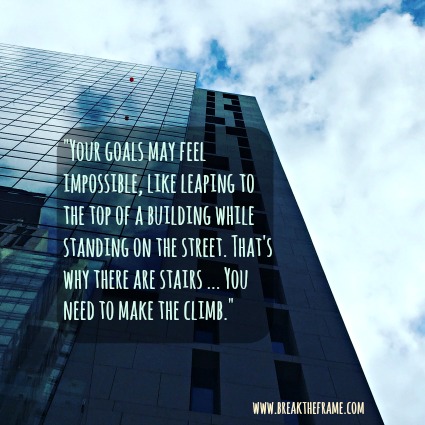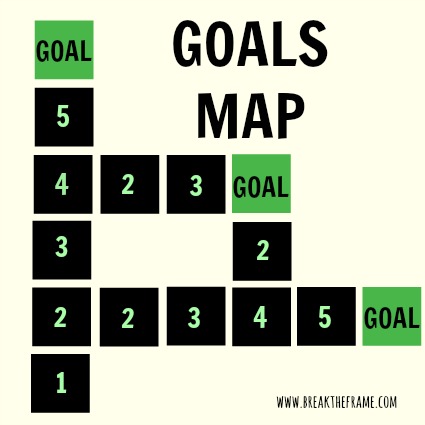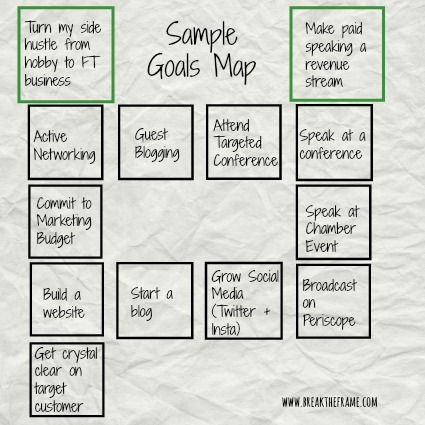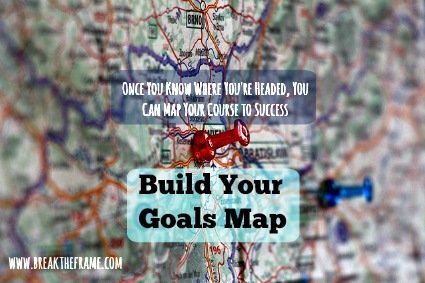January is a popular time to set big goals. “This year I want to… This year will finally be the year I… This is my year…
The year you what?
Lose weight?
Change jobs?
Write a book?
Start your business?
Get promoted?
No matter what your personal goal is, and no matter how much enthusiasm you have for it on January 1st, fatigue ultimately sets in. Only a short time into the new year, I’ll bet your goal that had you jumping out of bed a few weeks ago, now feels like a lot of work. Combined with slow progress, it’s tempting to give up or adjust your trajectory. Do not give up just because it feels too hard before you read on.
Why Many Goals Fail and What You Can Do to Avoid It
For most people, the issue isn’t that the goal is too big, it’s that the path forward is cloudy. They set the goal, often verbally or sometimes in a journal and then go for it. The problem is that the “going for it” isn’t a plan and ends up looking a lot like sitting on the stationary bike at the gym. You clock up miles but don’t move and inch.
A Map is Key to Beat Goals Fatigue and Create Success
A Goals Map is essentially your stairway from street level to the top of the building. It puts on paper not only your BIG goal but also creates a tangible path forward. Moreover, it gives you interim milestones and successes to celebrate along the way. The celebration is essential to keep up your momentum and motivation – after all, the top of that building is a long climb.

What is a Goals Map?
A Goals Map is a lot like any other map. It takes you from point A to point Z and helps you to plot your stops along the way. On a long road trip, there are often detours that open up new pathways and sustain the adventure. With a Goals Map, you can incorporate those turn offs and visualize how they will help you get to your final destination too.

At the simplest level, when building your Goals Map, you start with a goal in mind and fill in the boxes from your starting point to the end goal. Think of it not as a stone tablet or work plan but more like a treasure map. Once you reach each spot on the map, it makes the step to the very next box clear.
The Y-Axis, (Vertical) is your path to your primary goal.
The X-Axis (Horizontal) is where you can further flesh out steps from your primary goal (Y) and set additional goals that are related your original path.
Here’s a sample for someone who wants to turn their side hustle into a full-time business. You’ll notice that not every single step is represented at a granular level, but the map outlines a clear path forward.

5 Hot Tips for Using Your Goals Map to Kick Goals Fatigue to the Curb
Write It Down
Do not create the goals map in your head. Grab a notebook or your favorite online app and sketch it out. When you write down your goals, studies have shown that you increase your chance of reaching them.
Focus on Your Next Step
It can be tough to know all the steps between where you are now and your goal. When you are building your goals map, in each box ask yourself, “What’s my next logical step?” and don’t worry about four steps from here.
Build It From the Top Down or the Bottom Up
A trick you may want to use is to build your map from the top down. Ask yourself, “What needs to happen right before this is possible?” Decide what works for you – top down or bottom up and don’t worry about the way most people do it.
Post It
Now that you have your Goals Map put it somewhere you can see it and refer to it. There’s no point in writing it out if you never look at it again. Post it somewhere that you can refer to it and be reminded of where you are in the process.
Color It in and Check It Off
It’s powerful to see your progress and easy to feel like you aren’t making any. Use your map to help visualize progress. When you’ve completed a step, color it, check it off or put a pin in it. Equally important, don’t forget to celebrate.
Goals fatigue can stop you from creating the life and work that you most want. Instead of giving up and getting in bed or waiting for December for talk of “next year,” try a Goals Map. It works.
If you’re challenged while building your Goals Map, you may be interested in this article: 4 Ways to Overcome Indecision and Find Your Next Step
For additional support putting your Goals Map into action, this will help: A New Way to Think About How to Achieve Your Goals
Have you experienced Goals Fatigue? Have you used a Goals Map? Would love to hear your thoughts.



Excellent post about so many of the challenges we face with goal setting! I find that breaking everything down into small steps with timeframes attached to each can be helpful. I love your point: ” don’t worry about four steps from here.” I can be so overwhelmed thinking ahead.
I definitely will try your Goals Map. I never saw goal setting presented this way and I think it could be helpful.
Thanks Alli and will share!
I use a Goals Map before a work plan with times and dates. It’s really more of a map (but not street level) to think through what needs to happen and that one thing builds on another. There are tons of small steps embedded in here that do need to be fleshed out to get it done.
Thanks, Terri!
Alli
Quoting you: “A Goals Map is essentially your stairway from street level to the top of the building. It puts on paper not only your BIG goal but also creates a tangible path forward. Moreover, it gives you interim milestones and successes to celebrate along the way.”
May I suggest: Don’t spend an inordinate amount of time on the steps closest to your big goal – other than to provide a comfort level with the level of effort that will be needed. Rather, spend enough time to get the initial direction pretty well identified. (Though of course, these might need a restart from time to time anyhow.) Also, those interim milestones are key points – to provide the successes as noted – and also to provide opportunities for self-assessment, planning, and refinement of processes if not the goals map itself.
Bottom line: It’s virtually impossible to plan and develop a Goals Map (for a meaningful situation at least) that can be followed precisely to the useful outcomes. To think this to be so leads to wasted time and effort – as well as frustration and stress. Rely on your self-assessment and problem solving skills!!!
Happy New Year, John! Thanks for sharing your insights on this. I agree with many of your points.
A Goals Map is a visualization exercise in addition to a high level plan. Plans that are set in stone often break and we, as humans who are finding our way, need to flex. However, knowing that it’s possible to see a path is powerful. It’s born from the ladders that kids would use as a graphic organizer for goals. Knowing A path keeps us moving forward before giving up. As far as what we need to do to make it happen exactly, you should back off doing that four steps ahead and focus on figuring out your next step, and then the next and then the next, all the while having the map as a guide. There are always new roads to a final destination.
I worked with someone who wanted to lose a lot of weight. Instead of going full force, he used this as a plan to build up and add on to his routine over time. It also helped him to see that where he’s starting is not where he’s ending ad there is a progression.
Your thoughts are essential to fold into this activity.
Thanks, John!
Alli
Great tips here, Alli! I love them all. I would add that sometimes it’s important to reassess whether your micro goals need to change in order to achieve your macro goal. Often, the route or method of how to move forward is met with legitimate resistance or issues that were not foreseen. A re-evaluation of the steps to get there may need to be incorporated into the overall plan…
YES!! If we think of this as a map, we should adjust it to find other roads and ways forward towards our goals. Kind of like when Google Maps doesn’t know about a car accident or construction and we need to change course to get where we want to go. This is not a one and done activity but helpful for people who start to feel like there is no way to get from where they are to where they want to go. It’s the first road…
Alli
Great way to outline our goals and connect our actions to making it happen. An engaging process and points, Alli!
Thank you, Jon
Thanks, Jon! It’s helpful to see the rungs before you climb the ladder. Even knowing what may be ahead can keep up the stamina for where you are now.
Alli
Hi Alli,
I’ve missed your blog. Glad to be back and how perfect to have goals as the topic. Recent experience with a goal leads me to suggest that the vehicle on the road must be able to notice, “listen” and adapt, especially when it comes to managing competing goals.
I was traveling happily along my route, going at a high speed on a particular goal and ignoring the obvious on another one. I was focused, persistence and determined. Boom! The universe put up road blocks – literally 3 in one day – in an effort to have more balance. By the time the third one was encountered, I got the message.
I have recalibrate my speed in order to see some of the scenery along the way and even stop at rest stops every now and then.
Terri
Missed you and your insights! I’ve written in the past about roadblocks and your story truly brings home how real-life gives us the lesson we need until we learn it.
Notice, listen and adapt is an important mantra when going after our goals. With no flex, ultimately we come to a stop.
Thanks, Terri!
Alli